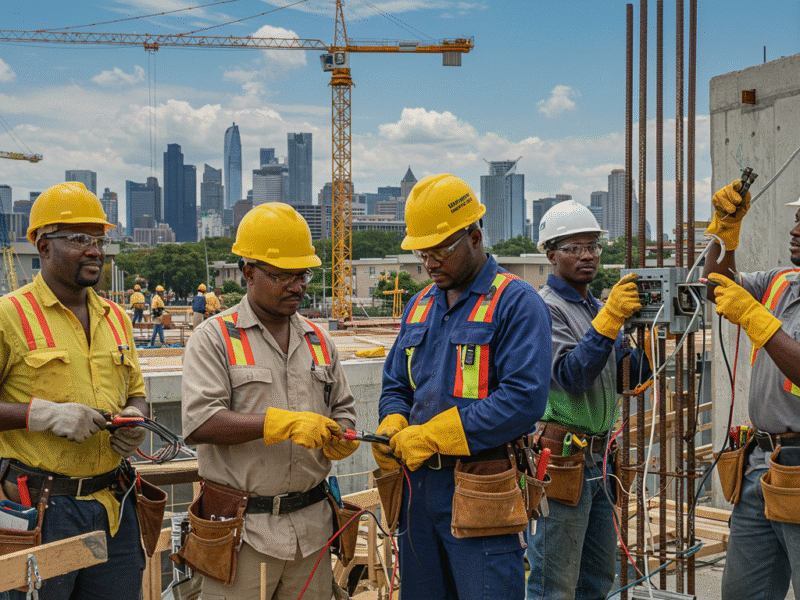Imagine sparking a new chapter in your career, where your skills as an electrician could power not just homes and businesses, but your future in the United States of America. The USA is buzzing with opportunities for skilled electricians, and many employers are offering visa sponsorship to bring talented professionals like you to their teams. From towering skyscrapers in New York to solar farms in California, the demand for electricians is surging, driven by infrastructure growth, renewable energy projects, and a shortage of local talent. If you’re an electrician dreaming of working in the USA with visa sponsorship, this guide will walk you through everything you need to know—qualifications, job search tips, visa processes, and the lifestyle awaiting you.
Why the USA Needs Electricians with Visa Sponsorship
The U.S. is experiencing an unprecedented boom in industries that rely on skilled electricians. The Bureau of Labor Statistics projects a 6% growth in electrician jobs through 2032, translating to over 40,000 new openings annually. This demand stems from massive investments in construction, renewable energy, and technology-driven infrastructure like electric vehicle (EV) charging stations and smart grids. However, with nearly 80,000 electrician positions unfilled due to retirements and limited training programs, employers are turning to international talent. Visa sponsorship allows companies to hire skilled workers from abroad, covering legal costs to secure work permits or even permanent residency.
Understanding Visa Sponsorship for Electricians
Visa sponsorship is when a U.S. employer agrees to support your legal entry and work authorization in the country. It’s a big commitment, as it involves navigating complex immigration processes on your behalf. For electricians, the most common visa types include:
- H-1B Visa: Designed for specialty occupations, this visa is often used for electricians with advanced skills, like automation or renewable energy expertise. It’s valid for three years, extendable to six, with an annual cap of 85,000.
- EB-3 Visa: A path to permanent residency for skilled workers. It requires proof that no U.S. worker is available for the job, making it ideal for electricians in high-demand areas.
- TN Visa: Available for Canadian and Mexican electricians under NAFTA, this visa is easier to obtain but limited to citizens of those countries.
- E-3 Visa: Exclusive to Australians, it’s similar to the H-1B but with fewer restrictions.
Each visa has specific requirements, like proving your qualifications and ensuring the employer files the correct petitions with the U.S. Citizenship and Immigration Services (USCIS).
Qualifications Needed for Sponsored Electrician Jobs
To land a U.S. electrician job with visa sponsorship, you’ll need to meet certain standards. Here’s what employers typically look for:
- Education: A high school diploma or equivalent, ideally with vocational training in electrical systems.
- Experience: At least 2-5 years of hands-on work in residential, commercial, or industrial electrical projects.
- Certifications: Credentials like a Journeyman Electrician license or international equivalents, such as those from the International Brotherhood of Electrical Workers (IBEW).
- Skills: Proficiency in wiring, blueprint reading, safety protocols, and knowledge of U.S. standards like the National Electrical Code (NEC). Specialized skills in solar, wind, or automation systems are a bonus.
- Language: Basic English proficiency, often verified through tests like TOEFL or IELTS, to ensure workplace communication and safety.
- Health and Background: A clean criminal record and medical clearance are required for visa approval.
Many sponsors assist with obtaining U.S. licenses, so don’t worry if you’re not yet certified stateside. Familiarity with Occupational Safety and Health Administration (OSHA) standards can give you an edge.
Where to Find Electrician Jobs with Visa Sponsorship
The job hunt starts with knowing where to look. Online platforms like Indeed, LinkedIn, and Glassdoor allow you to filter for “visa sponsorship” or “electrician jobs USA.” Use specific search terms like “electrician H-1B jobs” or “skilled trades visa sponsorship” to narrow results. Here are key industries and companies hiring:
- Construction: Firms like Bechtel and Fluor Corporation need electricians for large-scale projects, from airports to hospitals.
- Renewable Energy: Companies like Sunrun, Tesla, and First Solar are expanding solar and wind projects, often sponsoring international workers.
- Utilities: Power companies upgrading grids, like Duke Energy, seek skilled electricians.
- Manufacturing: Siemens and Eaton hire for factory automation and electrical maintenance.
- Government: Military bases and federal projects often require sponsored workers.
States like Texas, California, New York, Florida, and Washington lead in demand due to their booming construction, tech, and energy sectors. For example, Texas needs electricians for oil and gas infrastructure, while California’s green energy goals create thousands of solar jobs.
Salary and Benefits for Sponsored Electricians
One of the biggest draws of working in the USA is the pay. Entry-level electricians with visa sponsorship can earn around $50,000 annually, while experienced professionals make $80,000 or more. In high-cost areas like San Francisco or Seattle, top earners exceed $100,000. Unionized jobs, common in the electrical trade, offer even better wages, overtime, and benefits like:
- Health, dental, and vision insurance
- Relocation assistance
- Paid training or licensure support
- Family visa options for dependents
Compared to many countries, these salaries provide a comfortable lifestyle, though costs vary by region. For instance, the Midwest offers affordability, while coastal cities demand higher budgets.
The Visa Application Process
Securing a sponsored job involves several steps:
- Find a Sponsor: Apply to companies advertising visa sponsorship. Tailor your resume to highlight U.S.-relevant skills, like NEC compliance or programmable logic controller (PLC) experience.
- Employer Petition: Once hired, the employer files a petition with USCIS, like Form I-129 for H-1B visas. This proves the job’s necessity and your qualifications.
- Visa Application: You’ll submit forms like DS-160, attend an embassy interview, and provide documents (passports, certifications, health records).
- Approval and Arrival: If approved, you’ll receive your visa and can start work. Processing times vary—H-1B applications open in March and can take months, while EB-3 green cards may take years.
Legal fees are often covered by employers, but you might pay for application forms or attorney consultations, ranging from $500 to $2,000.
Challenges and How to Overcome Them
Relocating to the USA isn’t without hurdles. The visa process can be slow, with H-1B lotteries adding uncertainty. Competition is stiff, so your application must stand out. Cultural adjustments, like adapting to American work ethic (think long hours but high rewards), can feel daunting. Weather varies widely—freezing Midwest winters or humid Florida summers. Family separation is another concern if visas don’t initially cover dependents.
To overcome these:
- Polish Your Application: Use keywords like “OSHA compliance,” “smart grid technology,” or “EV charging systems” in your resume.
- Network: Connect with U.S. electricians on LinkedIn or forums like Reddit’s r/electricians.
- Prepare for Interviews: Expect technical questions, like troubleshooting a circuit or explaining NEC standards.
- Research Employers: Target companies with a history of sponsoring, like those in renewable energy or large construction.
Success Stories to Inspire You
Real stories show what’s possible. Raj, a master electrician from India, landed a sponsored job in Florida, working on hurricane-resistant electrical systems. Within two years, he became a supervisor, doubling his income. Maria, from Mexico, used a TN visa to work on Las Vegas casino lighting, leveraging her low-voltage expertise. These electricians highlight the rewards of persistence and preparation.
Tips for Landing Your Dream Job
Here’s how to boost your chances:
- Build a Portfolio: Include photos or descriptions of past projects, like industrial wiring or solar installations.
- Learn U.S. Standards: Study the NEC online or take courses on platforms like Coursera.
- Get Endorsements: Strong references from previous employers can make a difference.
- Attend Job Fairs: Virtual or in-person events for skilled trades often feature sponsors.
- Work with Agencies: Immigration-focused recruiters can match you with employers.
Top States and Industries for Electricians
Let’s break down where the action is:
- Texas: Oil and gas projects, plus residential growth in cities like Houston and Austin.
- California: Solar farms, EV infrastructure, and tech campuses in Silicon Valley.
- New York: Urban redevelopment and subway system upgrades.
- Florida: Tourism-driven construction, like hotels and theme parks.
- Washington: Data centers for tech giants like Amazon and Microsoft.
Industries hiring include:
- Construction: New buildings and renovations.
- Renewables: Solar, wind, and battery storage systems.
- Manufacturing: Factory automation and maintenance.
- Utilities: Power grid modernization.
- Entertainment: Stage lighting for concerts or studios.
Emerging Trends in the Electrical Trade
The industry is evolving fast. Smart homes, powered by IoT devices, need electricians skilled in automation. AI-driven systems require expertise in low-voltage wiring. The push for net-zero emissions means more work in solar, wind, and EV infrastructure. If you’re trained in these areas, your visa sponsorship chances skyrocket.
Life in the USA as a Sponsored Electrician
Beyond work, the USA offers a vibrant lifestyle. You’ll meet people from every corner of the world, especially in diverse cities like Miami or Chicago. Expect a mix of cultures, cuisines, and festivals. Work-life balance varies—union jobs often provide generous time off, while independent contractors hustle more. Housing depends on location; sponsors may help with apartments near job sites. Cars are essential outside major cities, so budget for one. Socially, join expat groups or trade unions to build a community.
Long-Term Opportunities
Visa sponsorship isn’t just a job—it’s a path to stability. Many electricians transition from H-1B to EB-3 visas, leading to green cards and citizenship. With experience, you could move into supervisory roles, start your own electrical business, or specialize in cutting-edge fields like renewable energy consulting. The USA rewards hard work with upward mobility.
Preparing for the Move
Before you pack your bags:
- Learn U.S. Work Culture: Americans value punctuality and clear communication.
- Understand Taxes: You’ll pay U.S. taxes, but treaties with your home country may prevent double taxation.
- Plan for Family: Some visas allow spouses to work or kids to attend school.
- Health and Safety: Familiarize yourself with OSHA regulations to stay safe on the job.
Overcoming Setbacks
If a visa application is denied, don’t give up. Explore alternative paths, like studying in the USA to gain a student visa, then transitioning to work authorization. Reapply with a stronger application or target different sponsors. Persistence is key.
The Future of Electricians in the USA
With federal infrastructure bills pumping billions into roads, bridges, and green energy, the demand for electricians will only grow. The shift to electrification—EVs, smart cities, renewable grids—ensures your skills will remain valuable. Visa sponsorship is your gateway to being part of this exciting future.
In conclusion, working as an electrician in the USA with visa sponsorship is a life-changing opportunity. It’s a chance to build a career, earn a competitive salary, and experience the American dream. With the right qualifications, a strategic job search, and a bit of grit, you can make it happen.
For more information, visit the official USCIS website here or explore job opportunities on Indeed here.











